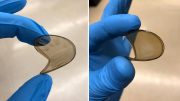
Researchers have made a pivotal advance in quantum technology by developing integrated photonics that enable the control and manipulation of light on silicon chips. This innovation facilitates ultra-secure communications and enhances quantum computing capabilities. Credit: SciTechDaily.com
A breakthrough in integrated photonics has allowed researchers to harness light manipulation on silicon chips, paving the way for improved quantum computing and secure communications.
They developed compact silicon ring resonators to manage 34 qubit-gates and established a novel five-user quantum network.
Quantum Leap in Integrated Photonics
In a significant leap forward for quantum technology, researchers have achieved a milestone in harnessing the frequency dimension within integrated photonics. This breakthrough not only promises advancements in quantum computing but also lays the groundwork for ultra-secure communications networks.
Integrated photonics, the manipulation of light within tiny circuits on silicon chips, has long held promise for quantum applications due to its scalability and compatibility with existing telecommunications infrastructure.
A silicon microresonator (left, SEM image) provides a parametric broadband source for frequency-entangled photon pairs 21 GHz apart to achieve frequency-encoded large-scale quantum networks. The result is a trusted-node-free, fully-connected network where users are linked by a two-qubit frequency-entangled state. Credit: Henry et al., doi 10.1117/1.AP.6.3.036003.
Breakthrough in Quantum Circuit Design
In a study published in Advanced Photonics, researchers from the Centre for Nanosciences and Nanotechnology (C2N), Télécom Paris, and STMicroelectronics (STM) have overcome previous limitations by developing silicon ring resonators with a footprint smaller than 0.05 mm² capable of generating over 70 distinct frequency channels spaced 21 GHz apart.
This allows for the parallelization and independent control of 34 single qubit-gates using just three standard electro-optic devices. The device can efficiently generate frequency-bin entangled photon pairs that are readily manipulable – critical components in the construction of quantum networks.
Enhancing Quantum State Control
The key innovation lies in their ability to exploit these narrow frequency separations to create and control quantum states. Using integrated ring resonators, they successfully generated frequency-entangled states through a process known as spontaneous four-wave mixing. This technique allows photons to interact and become entangled, a crucial capability for building quantum circuits.
What sets this research apart is its practicality and scalability. By leveraging the precise control offered by their silicon resonators, the researchers demonstrated the simultaneous operation of 34 single qubit-gates using just three off-the-shelf electro-optic devices. This breakthrough enables the creation of complex quantum networks where multiple qubits can be manipulated independently and in parallel.
To validate their approach, the team performed experiments at C2N, showing quantum state tomography on 17 pairs of maximally entangled qubits across different frequency bins. This detailed characterization confirmed the fidelity and coherence of their quantum states, marking a significant step towards practical quantum computing.
Milestones in Quantum Networking
Perhaps most notably, the researchers achieved a milestone in networking by establishing what they believe to be the first fully connected five-user quantum network in the frequency domain. This achievement opens new avenues for quantum communication protocols, which rely on secure transmission of information encoded in quantum states.
Future of Quantum Technologies
Looking ahead, this research not only showcases the power of silicon photonics in advancing quantum technologies but also paves the way for future applications in quantum computing and secure communications. With continued advancements, these integrated photonics platforms could revolutionize industries reliant on secure data transmission, offering unprecedented levels of computational power and data security.
Corresponding author Dr. Antoine Henry of C2N and Télécom Paris remarks, “Our work highlights how frequency-bin can be leveraged for large-scale applications in quantum information. We believe that it offers perspectives for scalable frequency-domain architectures for high-dimensional and resource-efficient quantum communications.” Henry notes that single photons at telecom wavelengths are ideal for real-world applications harnessing existing fiber optic networks integrated photonics allows the miniaturization, stability and scalability/ potential for increased complexity of devices, and thus efficient and custom photon pair generation to implement quantum networks with frequency encoding at telecom wavelength.
The implications of this research are vast. By harnessing the frequency dimension in integrated photonics, the researchers have unlocked key advantages including scalability, noise resilience, parallelization, and compatibility with existing telecom multiplexing techniques. As the world edges closer to realizing the full potential of quantum technologies, this milestone reported by C2N, Telecom Paris, and STM researchers serves as a beacon, guiding the way towards a future where quantum networks offer secure communication.
Reference: “Parallelization of frequency domain quantum gates: manipulation and distribution of frequency-entangled photon pairs generated by a 21 GHz silicon microresonator” by Antoine Henry, Dario A. Fioretto, Lorenzo M. Procopio, Stéphane Monfray, Frédéric Boeuf, Laurent Vivien, Eric Cassan, Carlos Alonzo-Ramos, Kamel Bencheikh, Isabelle Zaquine and Nadia Belabas, 28 June 2024, Advanced Photonics.
DOI: 10.1117/1.AP.6.3.036003









Be the first to comment on "How Silicon Ring Resonators Are Rewriting the Rules of Quantum Computing"